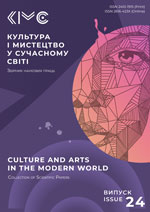Sociocultural Functions of Choral Art in Subcarpathian Ruthenia in the 1920s–1930s
DOI:
https://doi.org/10.31866/2410-1915.24.2023.287698Keywords:
choir, music, sociocultural functions, repertoire, community, Subcarpathian RutheniaAbstract
The aim of the article is to identify the institutionalisation level of the musical culture of Subcarpathian Ruthenia during the interwar period, to reveal the sociocultural functions of choral music in the region, and to determine the index of society's involvement in choral singing. Research results indicate an increase in the institutionalisation level of the region’s musical culture in the 1920s–1930s, involving broad segments of the population in choral performance. Active amateur and professional choral activities became indicators of growing national self-awareness and self-affirmation through various forms of civic and creative activities. Choral music became an effective means of patriotic education for the youth, the basis for the development of the region’s musical education, and a polylogue of ethnic musical traditions. The scientific novelty lies in defining the basic sociocultural functions of the choral art of Subcarpathian Ruthenia during the interwar period. The criteria for systematisation are the social and aesthetic needs of the region’s residents, the features of their national self-awareness, creative, and economic resources. Choral art is considered as an element of the general cultural process determined by social and historical events. Conclusions. The cultural life of Subcarpathian Ruthenia in the 1920s–1930s proves the multifunctionality of choral art. However, the sociocultural functions of choral music varied in intensity. The choir became a kind of sociocultural environment that served as a factor in attracting the population to spiritual and aesthetic values, fostering the creative realisation of individual moral potential, and representing the entire set of cultural activities of ethnic groups. Choral art emerged as a powerful ethno-creative force that used various forms of representing ethnic identity, demonstrating social aspirations, and preserving traditions.
References
Adorno, T. (1976). Introduction to the sociology of music (E. B. Ashton, Trans.). Continuum [in English].
Bench-Shokalo, O. H. (2002). Ukrainskyi khorovyi spiv: Aktualizatsiia zvychaievoi tradytsii [Ukrainian choral singing: Actualization of the customary tradition]. Redaktsiia zhurnalu "Ukrainskyi svit" [in Ukrainian].
Bermes, I. L. (2013). Ukrainskyi khorovyi spiv yak sotsiokulturne yavyshche [Ukrainian choral singing as a socio-cultural phenomenon]. Posvit [in Ukrainian].
DeNora, T. (2003). After Adorno: Rethinking Music Sociology (1st ed.). Cambridge University Press. https://doi.org/10.1017/CBO9780511489426 [in English]
Myloslavskyi, P. (1942). Ruska narodna pisnia (Puti istorychnoho rozvytku) [Russian folk song (Paths of historical development)]. Zoria, 2(1–2), 58–97 [in Ukrainian].
Rosul, T. (2002). Muzychne zhyttia Zakarpattia 20–30-kh rokiv XX stolittia [Musical life of Transcarpathia in the 20s and 30s of the 20th century] [Monograph]. PoliPrynt [in Ukrainian].
Rudlovchak, O. (Comp.). (1984). 50 rokiv ukrainskoho radiomovlennia v Chekhoslovachchyni [50 years of Ukrainian radio broadcasting in Czechoslovakia]. Slovatske pedahohichne vydavnytstvo [in Ukrainian].
Sadovenko, S. M. (2022). Khorove mystetstvo Ukrainy yak bahatorivnevyi sotsiokulturnyi fenomen v konteksti istorychnoho protsesu [Choral art of Ukraine as a multilevel socio-cultural phenomenon in the context of the historical process]. Culture and Contemporaneity, 1, 48–55. https://doi.org/10.32461/2226-0285.1.2022.262555 [in Ukrainian].
Statisticheskii obzor kul’turno-prosvetitel’nykh organizatsіi i predpriyatіi soglasno tipu prinadlezhnosti, sostavlennyi okruzhnymi narodoprosvetitel’nymi radami po polozhenіyu do dnya 31-go dekabrya 1928 g. [Statistical review of cultural and educational organizations and enterprises according to the type of affiliation, compiled by the district educational councils up to the day of December 31, 1928]. (1929). Zoria, 9(7–9), 6 [in Russian].
Synkevych, N. (2014). Teoretyko-metodolohichni zasady systematyzatsii sotsiokulturnykh funktsii ukrainskoho khorovoho mystetstva [Theoretical and methodological principles of systematization of social and cultural functions of the Ukrainian choral art]. Ukrainian Culture: The Past, Modern, Ways of Development, 20(1), 231–236 [in Ukrainian].
Voloshyn, A. (1929). Besidy na anketi o shkilnii reformi dnia 11 aprilia 1929 roku v Prazi [Conversations on the questionnaire about the school reform on April 11, 1929 in Prague]. Podkarpatskaia Rus, 8–9, 147–159 [in Ukrainian].
Yatsko, P. (1926). Sviato nashoi pisni [The holiday of our song]. In Kolomyika [Kolomiyka] (pp. 11–12). Unio [in Ukrainian].
Downloads
Published
How to Cite
Issue
Section
License

This work is licensed under a Creative Commons Attribution 4.0 International License.
Authors who publish in this journal agree to the following terms:
1) The authors reserve the right to the authorship of their work and transfer to the journal the right to first publish this work under the terms of the Creative Commons Attribution License, which allows others to freely distribute the published work with a mandatory reference to the authors of the original work and the first publication of the work in this journal.
2) The authors have the right to enter into independent additional agreements for non-exclusive distribution of the work in the form in which it was published by this journal (for example, to place the work in the electronic repository of the institution or to publish it as part of a monograph), provided that the reference to the first publication of the work in this journal is maintained.
3) The journal's policy allows and encourages authors to post their manuscripts on the Internet (for example, in institutional repositories or on personal websites) both before submitting the manuscript to the editorial board and during its editorial processing, as this contributes to the emergence of a productive scientific discussion and has a positive effect on the efficiency and dynamics of citation of published work (see The Effect of Open Access).






